|
|
 |
Fiche d'espèce de Copépode |
|
|
Calanoida ( Ordre ) |
|
|
|
Diaptomoidea ( Superfamille ) |
|
|
|
Candaciidae ( Famille ) |
|
|
|
Candacia ( Genre ) |
|
|
| |
Candacia simplex (Giesbrecht, 1889) (F,M) | |
| | | | | | | Syn.: | Candace simplex Giesbrecht, 1892 (p.424, 440, 771, figs.F,M);
C. parasimplex Brodsky, 1962 c (p.141, figs. juv.5 F); Kouwenberg, 1994 (tab.1);
Paracandacia simplex : Grice, 1963 (p.173, figs.F,M); Vervoort, 1965 (p.158, Rem.); Grice & Hulsemann, 1965 (p.225); Owre & Foyo, 1967 (p.96, figs.F,M); Vidal, 1968 (p.42, figs.F); Corral Estrada, 1970 (p.202, figs.F,M); Shih & al., 1971 (p.37); Razouls, 1972 (p.95, Annexe: p.84, figs.F,M); Kos, 1972 (Vol. I, figs. F, M, Rem.); Corral Estrada & Pereiro Muñoz, 1974 (tab.I); Lawson, 1977 (p.71, tab.2, 3, 4, fig.3, 5); Björnberg, 1981 (p.655, figs.F,M); Marques, 1982 (p.763, fig.F); Baessa De Aguiar, 1991 (1993) (p.105, figs.F,M); Suarez, 1992 (App.1); Chihara & Murano, 1997 (p.755, Pl.79, 80: F,M); Mulyadi, 1997 a (p.104, figs.F); Bradford-Grieve & al., 1999 (p.885, 955, figs.F,M); Bradford-Grieve, 1999 b (p.176, figs.F,M, Rem., figs.183,193); Conway & al., 2003 (p.113, figs.F,M, Rem.); Mulyadi, 2004 (p.102, figs.F, Rem.); Avancini & al., 2006 (p.102, Pl. 71, figs.F,M, Rem.); Vives & Shmeleva, 2007 (p.462, figs.F,M, Rem.)
Ref. compl.: Fleminger, 1967 a (tabl.1); Park, 1970 (p.478); Roe, 1972 (p.277, tabl.1, tabl.2); 1972 c (p.1038); Bainbridge, 1972 (p.61, Appendix Table III: occurrence); Björnberg, 1973 (p.351, 388); Deevey & Brooks, 1977 (p.156, tab.2, Station "S"); Carter, 1977 (1978) (p.36); Dessier, 1979 (p.206); Vives, 1982 (p.294); Dessier, 1983 (p.89, Tableau 1, Rem., %); Tremblay & Anderson, 1984 (p.4); Scotto di Carlo & al., 1984 (1042); Cummings, 1984 (p.163, Table 2); Guangshan & Honglin, 1984 (p.118, tab.); Regner, 1985 (p.11, Rem.: p.37); Madhupratap & Haridas, 1986 (p.105, tab.1); M. Lefèvre, 1986 (p.33); Brenning, 1985 a (p.28, Table 2); Brenning, 1987 (p.30, spatial distribution, T-S diagram, Rem.); Lozano Soldevilla & al., 1988 (p.60); Suarez & al., 1990 (tab.2); Ohtsuka & Kubo, 1991 (p.541); Suarez & Gasca, 1991 (tab.2); Shih & Young, 1995 (p.69); Suarez-Morales, 1998 (p.345, Table 1); Suarez-Morales & Gasca, 1997 (p.1525); Hure & Krsinic, 1998 (p.102); Alvarez-Cadena & al., 1998 (tab. 2, 3, 4); Suarez-Morales & Gasca, 1998 a (p109); Neumann-Leitao al., 1999 (p.153, tab.2); Siokou-Frangou, 1999 (p.478); Barthélémy, 1999 a (p.9, Fig.12, B); Seridji & Hafferssas, 2000 (tab.1); Razouls & al., 2000 (p.343, Appendix); Lopez-Salgado & al., 2000 (tab.1); Uysal & al., 2002 (p.17, tab.1); Hsiao & al., 2004 (p.325, tab.1); ; CPR, 2004 (p.58, fig.169); Lo & al., 2004 (p.89, tab.1); Osore & al., 2004 (p.195); G. Harding, 2004 (p.25, figs.F,M); Lavaniegos & Jiménez-Pérez, 2006 (p.150, tab.2, 3, Rem.); Khelifi-Touhami & al., 2007 (p.327, Table 1); Dur & al., 2007 (p.197, Table IV); Neumann-Leitao & al., 2008 (p.799: Tab.II, fig.6); C.-Y. Lee & al., 2009 (p.151, Tab.2); Hsiao S.H. & al., 2011 (p.475, Appendix I); Hsiao & al., 2011 (p.317, Table 2, indicator of seasonal change); Uysal & Shmeleva, 2012 (p.909, Table I); Jagadeesan & al., 2013 (p.27, Table 3, 5, 6, fig.11, seasonal abundance); Alvarez-Silva & Torres-Alvarado, 2013 (p.241, Table1: seasonal abundance) | | | | Ref.: | | | Giesbrecht & Schmeil, 1898 (p.130, Rem. F); Thompson & Scott, 1903 (p.235, 250); A. Scott, 1909 (p.154, Rem.); Wolfenden, 1911 (p.357); Pesta, 1920 (p.539); Sars, 1925 (p.351); Rose, 1925 (p.152); 1929 (p.43); Farran, 1929 (p.210, 273); Sewell, 1932 (p.338); Rose, 1933 a (p.256, figs.F,M); Farran, 1936 a (p.115); Wilson, 1936 c (p.92); Mori, 1937 (1964) (p.86, figs.F); Wilson, 1942 a (p.175, figs.F,M); Massuti Alzamora, 1942 (p.95, Rem.); Lysholm & al., 1945 (p.41); Sewell, 1947 (p.247); 1948 (p.392, 396, 408, 412, 415, 433, 443, 451, 460, 470, 475, 490); Moore, 1949 (p.60); C.B. Wilson, 1950 (p.182); Chiba, 1956 (p.42, figs.F); Chiba & al., 1957 (p.310); 1957 a (p.11); Grice, 1962 (p.235, figs.F,M); Ganapati & Shanthakumari, 1962 (p.9, 15); Fagetti, 1962 (p.34); Duran, 1963 (p.24); Giron-Reguer, 1963 (p.37); V.N. Greze, 1963 a (tabl.2); Shmeleva, 1963 (p.141); Paiva, 1963 (p.68, figs.M); et auteurs avant 1963: cf. in Vervoort, 1965 (p.158); De Decker & Mombeck, 1964 (p.11); El-Maghraby, 1965 (p.56, Appendix); Chen & Zhang, 1965 (p.93, figs.F); Mazza, 1966 (p.72); 1967 (p.329, 360: Rem.); Pavlova, 1966 (p.44); Evans, 1968 (p.12); Vinogradov, 1968 (1970) (p.268, 269); Dowidar & El-Maghraby, 1970 (p.267); Deevey, 1971 (p.224); Apostolopoulou, 1972 (p.328, 365); Tranter, 1977 (p.596, 601); Kovalev & Shmeleva, 1982 (p.85); De Decker, 1984 (p.317, 337: carte); Jansa, 1985 (p.108, Tabl. III); Hernandez-Trujillo, 1989 a (tab.1); Gilabert & Moreno, 1998 (tab.1, 2); Barthélémy & al., 1998 (p.721, genital area); Barthélémy, 1999 (fig.12 B, E); Moraitou-Apostolopoulou & al., 2000 (tab.I); Boxshall & Halsey, 2004 (Rem: p.84; p.85: fig.M); Blanco-Bercial & al., 2011 (p.103, Table 1, Biol. mol, phylogeny) |  issued from: Q.-c Chen & S.-z. Zhang in Studia Marina Sinica, 1965, 7. [Pl.38, 7-9]. Female (from E China Sea): 7, habitus (dorsal); 8, urosome (lateral right side); 9, exopod of right P3 (posterior).
|
 issued from : J. Corral Estrada in Tesis Doct., Univ. Madrid, A-129, Sec. Biologicas, 1970. [Lam.53, figs.1-3]. As Paracandacia simplex. Female (from Canarias Is.): 1, P5. Male: 2, P5; 3, portion of right A1.
|
 issued from : Mulyadi in Treubia, 1997, 31 (2). [p.105, Fig.14]. As Paracandacia simplex. Female (from Flores Sea and Banda Sea): A, habitus (dorsal); B, angles of the 5th metasomal somite and urosome (dorsal); C, idem, with spermatophore (lateral left side); D, right caudal ramus (dorsal); E, A1; F, Mx2; G, P3; H, P5 (anterior view).
|
 issued from : C. Razouls in Th. Doc. Etat Fac. Sc. Paris VI, 1972, Annexe. [Fig.54, A]. As Paracandacia simplex. Male: A, P5
|
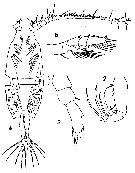 issued from : T. Mori in The Pelagic copepoda from the neighbouring waters of Japan, 1937 (1964). [Pl. 59, Figs.2-5]. Female: 2, Mx2; 3, P5; 4, habitus (dorsal); 5, P3.
|
 issued from : G.D. Grice in Fish. Bull. Fish and Wildl. Ser., 1962, 61. [p.237, Pl.33, Figs.1-5]. Male (from equatorial Pacific): 1-2, habitus (dorsal and lateral, respectively); 3, segments 17 to 21 of right A1; 4, Mx2; 5, P5. Nota: Thorax and urosome stmmetrical. Right P5 similar to that of C. bispinosa; left P5 terminates in 3 setae, the middle one of which is the longer, the penultimate segment is not particularly enlarged.
|
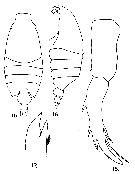 issued from : G.D. Grice in Fish. Bull. Fish and Wildl. Ser., 1962, 61. [p.236, Pl.32, Figs.15-18]. Female (from equatorial Pacific): 15-16, habitus (dorsal and lateral, respectively); 17, Md (biting edge); 18, P5. Genital segment slightly asymmetrical, with a group of small hair-like structures visible on the right side. Terminal finger of the distal segment of P5 finely serrate on the external margin; of the 2 internal setae on this segment, the distal one is approximately twice the length of the proximal one.
|
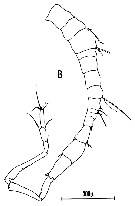 issued from : C. Razouls in Thèse Doc. Etat Fac. Sc. Paris VI, 1972, Annexe. [Fig.55, B]. As Paracandacia simplex. Male (from Banyuls): A, right A1.
|
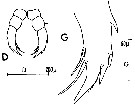 issued from : C. Razouls in Thèse Doc. Etat Fac. Sc. Paris VI, 1972, Annexe. [Fig.53, D, G]. As Paracandacia simplex. Female (from Banyuls, G. of Lion): D, P5; G, distal portion of P5 (enlarged).
|
 issued from : G. Harding in Key to the adullt pelagic calanoid copepods found over the continental shelf of the Canadian Atlantic coast. Bedford Inst. Oceanogr., Dartmouth, Nova Scotia, 2004. [p.25]. As Paracandacia simplex. Female & Male.
|
 issued from : R.-M. Barthélémy in Thèse Doct. Univ. Provence (Aix-Marseille I), 1999. [Fig.12, B]. Female (from Gulf of Marseille, NW Mediterranean Sea): B, external ventral view genital double-somite. go = genital operculum; Note the complex operculum with two lateral lobes (arrowed).
|
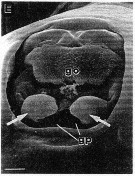 issued from : R.-M. Barthélémy in Thèse Doct. Univ. Provence (Aix-Marseille I), 1999. [Fig.12, E]. Female (from Gulf of Marseille, NW Mediterranean Sea): B, external ventral view genital double-somite (details of operculum structure). go = genital operculum; gp = gonoporal plate. Note the complex operculum with two lateral lobes (arrowed). Scale bar: 0.010 mm.
|
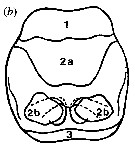 issued from : R.-M. Barthélémy, C. Cuoc, D. Defaye, M. Brunet & J. Mazza in Phil. Trans. R. Soc. Lond., B, 1998, 353. [p.729, Fig.54 b]. b, Schematic external genital area Candacia simplex. Nota: Compare with C. armata, C. bispinosa and C. ethiopica. Homologous structures have the same number: 1, anterior thickening of genital operculum; 2a, median part of genital operculum; 2b, lateral expansions of genital operculum; 3, posterior pad.
|
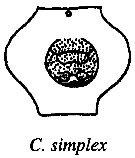 issued from : R.-M. Barthélémy, C. Cuoc, D. Defaye, M. Brunet & J. Mazza in Phil. Trans. R. Soc. Lond., B, 1998, 353. [p.733, Fig.63]. Schematic representation of external genital area in the species studied; Dashed line, limit of the anterior pad and lateral thickenings; shading, posterior pad; dots, genital operculum.
|
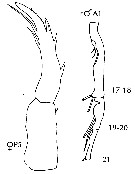 Issued from : J.M. Bradford-Grieve, E.L. Markhaseva, C.E.F. Rocha & B. Abiahy in South Atlantic Zooplankton, edit. D. Boltovskoy. 1999, Vol. 2, Copepoda; [p.1066, Fig. 7.376: Paracandacia simplex (= Candacia simplex)]. r : right. Female characters (from key, p.955): - P5 terminal segments end in processes at least one of which is finger-like process and may be finely serrated on one or both margins. - In dorsal view, genital segment without spine-like protrusions. - P5 terminal finger-like process finely serrate proximally: distal seta on inner margin approximately twice as long as proximal seta; points of posterior corners of prosome directed backwards Male (from key, p.925): - P5 not chelate on right but ends in long plumose seta; right A1 has no teeth in geniculate region. - Right A1 segments 16 and 19-20 without rounded or elongate protrusions.
|
 Issued from : W. Giesbrecht in Fauna Flora Golf. Neapel, 1892, 19. [Taf. 39, figs. 3, 14]. Female: 3, habitus (dorsal); 14, urosome.
| | | | | Ref. compl.: | | | Chatton, 1920 (p.17); Gaudy, 1962 (p.93, 99, Rem.: p.113) ; Ahlstrom & Thrailkill, 1963 (p.57, Table 5, abundance); Björnberg, 1963 (p.57, Rem.); Gaudy, 1963 (p.28, Rem.); Ehrhardt, 1967 (p.741, geographic distribution, Rem.); Timonin, 1971 (p.281, trophic group); Desgouille, 1973 (p.1, 131, Rem.: p.138); Fernandes, 2008 (p.465, Tabl.2); Ayon & al., 2008 (p.238, Table 4: Peruvian samples); Dias & al., 2010 (p.230, Table 1); Schnack-Schiel & al., 2010 (p.2064, Table 2: E Atlantic subtropical/tropical); Mazzocchi & Di Capua, 2010 (p.424); Medellin-Mora & Navas S., 2010 (p.265, Tab. 2); Maiphae & Sa-ardrit, 2011 (p.641, Table 2); Tutasi & al., 2011 (p.791, Table 2, abundance distribution vs La Niña event); Andersen N.G. & al., 2011 (p.71, Fig.3: abundance); Uysal & Shmeleva, 2012 (p.909, Table I); Belmonte & al., 2013 (p.222, Table 2, abundance vs stations); in CalCOFI regional list (MDO, Nov. 2013 ; M. Ohman, comm. pers.); Lidvanov & al., 2013 (p.290, Table 2, % composition); Bonecker & a., 2014 (p.445, Table II: frequency, horizontal & vertical distributions); Dias & al., 2015 (p.483, Table 2, abundance, biomass, production); Zakaria & al., 2016 (p.1, Table 1); Benedetti & al., 2016 (p.159, Table I, fig.1, functional characters); El Arraj & al., 2017 (p.272, table 2, spatial distribution); Benedetti & al., 2018 (p.1, Fig.2: ecological functional group) ; Belmonte, 2018 (p.273, Table I: Italian zones); Acha & al., 2020 (p.1, Table 3: occurrence % vs ecoregions). | | | | NZ: | 21 | | |
|
Carte de distribution de Candacia simplex par zones géographiques
|
| | | | | | | | | | | | | | | 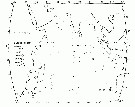 issued from : T.J. Lawson in Marine Biology, 1977, 43. [Fig.5, p.80]. As Paracandacia simplex. issued from : T.J. Lawson in Marine Biology, 1977, 43. [Fig.5, p.80]. As Paracandacia simplex.
Distribution map for the Indian Ocean. |
 issued from : Mulyadi in Treubia, 1997, 31 (2). [p.109, Fig.16]. issued from : Mulyadi in Treubia, 1997, 31 (2). [p.109, Fig.16].
Distribution of Candaciidae in Indonesian waters. 13: C. simplex. |
 issued from : U. Brenning in Wiss. Z. Wilhelm-Pieck-Univ. Rostock - 36. Jahrgang 1987. Mat.-nat. wiss. Reihe, 2. [p.27, Fig.1]. issued from : U. Brenning in Wiss. Z. Wilhelm-Pieck-Univ. Rostock - 36. Jahrgang 1987. Mat.-nat. wiss. Reihe, 2. [p.27, Fig.1].
Spatial distribution for Candacia curta, C. armata, C. bipinnata, C. paenelongimana, C. varicans (as varians), C. pachydactyla, C. longimana, C. ethiopica, Paracandacia simplex ( = C. simplex) from 8° S - 26° N; 16°- 20° W, for different expeditions (V1: Dec. 1972- Jan. 1973; V2: Feb/Mar. 1973; VI: May 1974; IV: Jun./Jul. 1972). |
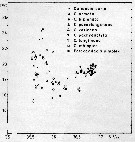 issued from : U. Brenning in Wiss. Z. Wilhelm-Pieck-Univ. Rostock - 36. Jahrgang 1987. Mat.-nat. wiss. Reihe, 2. [p.28, Fig.2]. issued from : U. Brenning in Wiss. Z. Wilhelm-Pieck-Univ. Rostock - 36. Jahrgang 1987. Mat.-nat. wiss. Reihe, 2. [p.28, Fig.2].
T-S Diagram for Candacia curta, C. armata, C. bipinnata, C. paenelongimana, C. varicans, C. pachydactyla, C. longimana, C. ethiopica, Paracandacia simplex ( = C. simplex) from 8° S - 26° N; 16°- 20° W. |
| | | | Loc: | | | sub-Antarct (S Patagonia), South Africa (E & W), Congo, off St. Helena Is., G. of Guinea (off Lagos), off E Trindade Is., Sao Tomé, Cape Verde Is., Morocco-Mauritania, Canary Is., off Madeira, Azores, Argentina, Brazil, off Rio de Janeiro, Campos Basin, off Natal, off Amazon, Barbada Is., Venezuela, Caribbean Colombia, Caribbean Sea, Yucatan, G. of Mexico, Cuba, Florida, Sargasso Sea, off Bermuda (Station "S"), off Nova Scotia, G. of St. Lawrence, off E Newfoundland, off SW Ireland, Medit. (Alboran Sea, Gulf of Annaba, Baleares, Banyuls, G. of Lion, Marseille, Toulon Harbour, Ligurian Sea, Tyrrhenian Sea, Napoli, Strait of Messina, Gulf of Taranto, Adriatic Sea, Malta, Ionian Sea, Aegean Sea, Lebanon Basin, Egyptian coast, Alexandria), Red Sea, Arabian Sea, Arabian Gulf, Laccadive Is., Sri Lanka, Mombasa, off Kenya, Natal, Madagascar, Rodrgues Is. - Seychelles, Indian, India (Lawson's Bay, G. of Mannar), Bay of Bengal, W Australia, Indonesia-Malaysia, Flores Sea, N Celebes, Philippines, Viet-Nam ( Cauda Bay), China Seas (East China Sea, South China Sea), Taiwan, Kuroshio Current, Japan, off Honshu, Bering Sea, Aleutian Is., Alaska, Pacif. (W equatorial), Australia (Great Barrier), SE Tasmania, Tasman Sea, New Zealand (NW North island), California, W Baja California, Coyuca lagoon (Guerrero), Hawaii, Moorea Is., E Tuamotu, W Galapagos, NE Easter Is., Galapagos-Ecuador, off W Peru, W Colombia, Chile, Drake Passage | | | | N: | 161 (S Alant.: 20; N Atlant.: 43; Medit.: 39; Red Sea: 1; Indian: 22; Indonesia-Malaysia: 3; Pacif.: 33) | | | | Lg.: | | | (16) F: 1,82-1,8; (34) F: 1,92-1,62; M: 2,2-2,04; (35) [N-Z] F: 2,3; M: 2,04-1,92; [Atlant. trop.] F: 1,85; M: 1,92; (46) F: 2,1-1,85; M: 2-1,8; (73) M: 2,2-1,98; (101) F: 1,93-1,67; M: 1,83-1,73; (180) F: 1,99; 1,98; M: 2,06; 1,98; (187) F: 2,32; (199) F: 2,05-1,75; M: 2,05-1,82; (237) F: 1,7; M: 2,3; (290) F: 2; (449) F: 2,1-1,85; M: 2-1,8; (778) F: 1,83; 1,80; (909) F: 2,05; (920) F: 1,99; (991) F: 1,67-1,93; M: 1,73-1,8; (1110) F: 1,9-2,26; M: 2,06; (1122) F: 1,83; {F: 1,62-2,32; M: 1,73-2,20}
The mean female size is 1.924 mm (n = 28; SD = 0.1326), and the mean male size is 1.982 mm (n = 20; SD = 0.1638). The size ratio (male : female) is 1.06 (n = 9; SD = 0.1361). | | | | Rem.: | épi-mésopélagique.
Sampling depth (sub-Antarct.) : 0-1000 m.
Voir aussi les remarques en anglais | | | Dernière mise à jour : 25/10/2022 | |
|
|
 Toute utilisation de ce site pour une publication sera mentionnée avec la référence suivante : Toute utilisation de ce site pour une publication sera mentionnée avec la référence suivante :
Razouls C., Desreumaux N., Kouwenberg J. et de Bovée F., 2005-2025. - Biodiversité des Copépodes planctoniques marins (morphologie, répartition géographique et données biologiques). Sorbonne Université, CNRS. Disponible sur http://copepodes.obs-banyuls.fr [Accédé le 27 décembre 2025] © copyright 2005-2025 Sorbonne Université, CNRS
|
|
 |
 |























